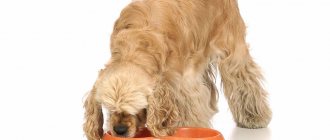Feeding dry food
Ready-made food is represented not only by dry granules, but also by wet canned food. From the variety of products in the store, you need to choose only those that belong to the premium class and higher - the economy segment will only harm your dog’s health.
Don't forget about water. A fresh and clean supply of water should always be available. Lack of fluid can lead to the development of kidney and liver disease.
The volume of a serving of finished food is calculated based on the manufacturer’s recommendations on the packaging, taking into account weight and age. Until 4 months of age, puppies are fed food labeled “puppy”. Then you can enter “junior”, but do it gradually.
Pets are transferred to “adult food” based on their breed variety:
- toy and miniature poodle - after changing teeth;
- small – after 10 months;
- big - after a year.
Many large manufacturers of premium food and higher have breed lines of food, with specified recommendations for transferring puppies to a new age type of food.
How to choose dry food
When choosing ready-made food, you should always be guided by the rule - cheap economy-class food is not suitable for complete nutrition for dogs. Even if the manufacturer claims that red and green granules are vegetables and fruits, the owner must remember that this is a dye. Such a chemical additive will harm your pet and cause allergies.
When choosing food, pay attention to the country of manufacture - an American diet produced, for example, in Poland, will be inferior in quality to the original.
We also performed a detailed analysis of the following feeds: Proplan, Monje, Dog Chow, Brit.
When to change food
- The dog has obvious signs of an allergic reaction: scabies, running eyes, hair falling out or dulling. It is necessary to exclude all possible allergens, primarily food ones. It is worth choosing another food from the line of hypoallergenic, medicinal or holistic;
- a disease requiring dietary or special nutrition has been diagnosed;
- the dog refuses food;
- the physiological state has changed: pregnancy, growing up or old age.
Photo: pxhere.com
What type of food to choose
Representatives of the breed are suitable for 2 nutritional plans:
- ready-made food;
- natural products.
Each of them has both advantages and disadvantages.
Ready-made dog food
Many dog breeders believe that ready-made food is the best solution to ensure the health of their pet. They are well balanced and contain the optimal amount of nutrients.
Manufacturers produce various lines for puppies, adults, elderly dogs, pregnant and lactating females, and sick animals. Therefore, finding suitable food will not be difficult. The daily amount of food is very easy to calculate - just adapt the recommendations indicated on the package to the size and activity of the dog.
Using ready-made products saves a lot of time - the owner does not need to prepare a fresh portion every day. Dry food is convenient to take with you - this is a significant advantage for owners of show animals and those who travel a lot.
However, not all commercial food is created equal. Ready-made food is divided into several classes, which differ in composition and, accordingly, cost. Cheap products contain no natural meat and a minimum of vitamins and minerals. But it contains preservatives and flavoring and aromatic additives, so it is not suitable for daily nutrition.
Food for poodles should be at least premium. It is sold in pet stores, not supermarkets.
Dog breeders prefer to feed their pets the following brands:
- RoyalCanin;
- Hill's;
- ProPlan;
- Monge;
- Eukanuba;
- Acana;
- DogChow;
- Brit.
If your poodle has an allergy, you should consult a veterinarian and replace the food with medicinal or holistic food.
On a note. You can diversify the menu with canned food from the same manufacturer as the dry granules.
When feeding dry food, it is important to buy products that are appropriate for the age of the pet. Puppies up to 4 months are given food labeled “puppy”, then gradually switched to “junior”.
The dwarf poodle and toy variety begin to be fed with food for adult dogs at 6–7 months (when the change of teeth ends), for small dogs at 11 months, for large dogs after a year.
Natural products
Adherents of natural nutrition believe that it is closest to the natural diet of dogs. With this approach, owners are confident that they feed the poodle only fresh and high-quality food.
Lack of natural nutrition - labor and time costs. The dog owner will have to prepare food for the pet daily. You can freeze a few portions for an emergency, but it is best not to use this method on a regular basis.
In addition to meat and offal, sea fish is a good source of protein. It is given 1-2 times a week. All bones, scales, fins and entrails are first removed.
To maintain your pet's energy, you need carbohydrate foods. The main part of saccharides is rice and buckwheat porridges; oatmeal porridge can be given occasionally. Their number is about 30% of the total food volume. It is not recommended to feed your dog other cereals - they can cause allergies.
Another important component of the poodle diet is fermented milk products with a fat content of up to 9%. Cottage cheese, kefir, unsweetened yogurt, and yogurt are suitable. They are rich in protein, fatty acids, vitamins and calcium, which are necessary for the functioning of the nervous, skeletal and cardiovascular systems.
The menu is supplemented with vegetables. They contain fiber, slow carbohydrates and nutrients.
Poodles can be fed:
- pumpkin;
- cauliflower;
- carrots;
- cucumbers;
- broccoli;
- zucchini.
Vegetables are given both boiled and raw, cut into small pieces. Vegetable oil or sour cream is suitable for salad dressing.
It is recommended to season food with herbs - spinach, dill, young nettle and dandelion leaves. Fruits - bananas, apples, pears - are used as delicacies.
A couple of times a week, add 1 boiled chicken or 2 quail eggs to your food. They contain animal protein, folic acid, amino acids, minerals and vitamins that support healthy coats and strong muscles.
The nutritional needs of poodles per kilogram of body weight look something like this:
- proteins – 4–5 g;
- fats – 1–2 g;
- carbohydrates – 12–15 g.
The approximate menu for the week presented in the table will help you correctly formulate your poodle’s diet.
| Day | Feeding | Products |
| 1 | Morning | Cottage cheese with vegetables/apple, oatmeal |
| Evening | Beef with rice, stewed vegetables | |
| 2 | Morning | Sea fish with vegetables and buckwheat |
| Evening | Rice porridge with turkey and pumpkin | |
| 3 | Morning | Beef with vegetables |
| Evening | Tripe, chicken egg, vegetable salad | |
| 4 | Morning | Sea fish, vegetables/fruits |
| Evening | Tripe with vegetables | |
| 5 | Morning | Beef and liver with vegetables and buckwheat porridge |
| Evening | Rice porridge cooked in meat and bone broth with vegetables | |
| 6 | Morning | Like 1 day |
| Evening | ||
| 7 | Morning | Like on day 4 |
| Evening |
Mixed nutrition
It is extremely undesirable to mix natural food and ready-made food - this can lead to disruptions in the functioning of the gastrointestinal tract. The poodle's digestive system gets used to a certain type of food and begins to produce gastric juice in the appropriate concentration. Sudden changes in diet lead to indigestion.
In addition, dry food and natural products require different times to digest. For the first - from 3 to 5 hours, for the second - only 2.
For your information. Only fermented milk products are allowed to be added to dry granules. They improve intestinal microflora.
When transferring from one type of nutrition to another, they act gradually. New food is gradually mixed into the usual food. First, replace 1/4 of the serving, after 3-4 days - ½, etc. If an allergy appears, return to the proven diet.
Natural diet
Rules for cooking natural food:
- products can be either raw or thermally processed;
- raw meat should be pre-frozen in the freezer;
- cooked food should be at room temperature;
- Depending on the size of the animal, the food is cut into pieces.
What should be included in a natural diet:
- meat: beef, turkey;
- cereals (rice and buckwheat);
- meat by-products - only as an addition;
- fish – marine species, cleaned of bones. Boiled. Replace meat once or twice a week;
- fermented milk products – low fat content (up to 9%);
- vegetables and fruits – raw or stewed;
- oils and vitamin supplements.
Each new product is introduced gradually and little by little, observing the reaction of the dog’s body.
Natural nutrition requires constant preparation of a new fresh portion, which can be stored in the refrigerator for no more than two days. To make the process easier, you can prepare home-made canned food: mince meat, offal and vegetables, adding vitamins and oil. The minced meat is packaged and frozen. Immediately before feeding, warm up, adding cereal and fresh food.
Menu for the week
| Day of the week | Menu |
| Monday |
|
| Tuesday |
|
| Wednesday |
|
| Thursday |
|
| Friday |
|
| Saturday |
|
| Sunday |
|
I wonder if poodles eat quail eggs?
Basic diet for a poodle
All dogs are carnivores. Therefore, a poodle’s diet consists of 40–50% meat products:
- lean meat - beef, rabbit, turkey;
- offal - heart, lungs, liver, tripe.
These are valuable sources of protein and vitamins necessary for development and proper metabolism.
The meat must be kept in the freezer for 2-3 days or scalded with boiling water to destroy bacteria and parasites. It is cut into pieces of such a size that the poodle can swallow them whole.
Pets are fed offal 2-3 times a week. They are not as high in calories as meat, so the serving should be 40-50% larger.
What not to feed
To avoid allergies, exclude the poodle from the diet or introduce with caution:
- chicken meat;
- soy products;
- corn;
- yeast products;
- wheat.
Products are strictly prohibited:
- sweet, smoked, with lots of spices;
- tubular bones. For miniature poodles and toys, any type of bone is prohibited;
- honey – high risk of allergies;
- food sweeteners (xylitol);
- grapes, raisins, apricots and plums;
- salt.
If a dog is not eating well , but continues to remain active and cheerful, this is not a cause for concern. Perhaps your poodle is not getting enough exercise or the food in his bowl is not fresh. It's worth waiting until your next meal to make sure everything is ok. There is no need to increase the portion.
If your dog looks sick and lethargic, consult a doctor.
Rules and features of feeding a poodle
To properly feed a poodle, you must follow several important rules:
- The breed is prone to food allergies, so it is better to buy hypoallergenic food. When eating natural foods, you should carefully select foods.
- Dogs are fed in a quiet place strictly according to schedule. It is not advisable to combine feeding an animal with eating people.
- If there are several pets living in the house, each of them should have separate dishes.
- Representatives of the breed have high withers, so it is uncomfortable for them to eat from the floor. You should immediately buy a stand with a height adjuster and place the bowls at the level of the animal’s shoulder.
- The pet is fed 2 hours before or after a walk - physical activity on a full stomach is harmful to health.
- The bowl is removed 15–20 minutes after the start of feeding, even if the dog has not finished eating. When a pet constantly leaves food, the portions are slightly reduced. Greedy licking of dishes indicates the need to increase the amount of food.
- Food should be at room temperature.
- Poodles quickly gain excess weight - they should not be overfed.
The fact that the diet is composed correctly is evidenced by the poodle's shiny coat and excellent physical shape.
What to feed a poodle puppy
| Age (number of feedings) | Nutrition |
| 4-5 weeks (6-8) | In addition to mother's milk, you can start complementary feeding: formula milk, cottage cheese, porridge, puppy food. |
| 2-3 months (4-5) |
|
| 4 months (3) | The diet remains the same; for large and small poodles the portion size is increased. For toys and dwarfs, the portion is not increased, but one more feeding per day is added if necessary. |
| 4-6 months (3) | Fish and offal, vegetable oil are introduced. Puppies are transferred to a “junior” diet of dry food. |
| 6 months – 1 year (2 or 3) | The set of products is saved by empirically determining the serving size. |
Watch Marsik and Velvet the toy poodle get their first feeding.
And here is the first independent feeding.
What to feed during pregnancy and after childbirth?
The expectant mother needs increased nutrition. During the first 3 weeks of pregnancy, when the fetuses are still very small, the diet does not change. Then the amount of food is increased weekly by 10%.
For your information. When eating dry food, the poodle is switched to food for pregnant women.
The growing uterus begins to put pressure on the stomach and other internal organs. Therefore, the dog is fed 4-5 times a day in small portions. To replenish the supply of minerals, feed additives are included in the diet. They are selected together with a veterinarian.
After giving birth, the poodle is fed 3-4 times a day. The amount of food depends on the size of the litter. If there are four puppies, a double norm will be required, if eight – a triple norm.
When babies begin to be fed, the portions are gradually reduced. After the end of lactation, a fasting day is carried out - they give ¼ of the usual amount of food. Return to the previous regimen within 3-4 days.
What to feed an adult poodle
Interestingly, the serving size of poodles of various sizes does not depend directly on their weight. Smaller representatives of the breed require more feed per 1 kg of their weight. In addition, the dog’s activity, temperament and age will also affect the portion size.
| Diet (approximately) | Large (royal) (g/day) | Small (g/day) | Dwarf and toy (g/day) |
| meat and lean trimmings | 450-500 | 300-350 | 250 |
| cereals | 350-500 | 150 | 50 |
| vegetables fruits | 300 | 200 | 150 |
| eggs (boiled) (pcs.) | 1-2-3 times a week | 1-2 times a week | 1 time per week |
| sour milk | 250 | 150 | 100 |
| dry bread or crackers (pcs.) | 3 - after meals (you can bones) | 2 | 1 |
Small poodles need to be fed more frequently and in smaller portion sizes. With a natural diet, additional vitamin complexes are needed to provide the dog with the necessary substances. On a ready-made diet, such feeding is not required.
This little guy can't wait to eat.
Big (royal)
The main feature of nutrition is to prevent overfeeding and, as a result, obesity of the animal. The dog should remain stately and slender, the ribs should be palpable and not covered in fat.
Mini (dwarf)
These dogs are very active, smart and cunning. They are big gourmands, are constantly looking for tasty treats and are ready to understand everything from the ground up. You should strictly monitor your pet’s diet and remove bowls immediately after eating.
Toy
Most prone to allergies and overeating. These babies constantly ask for food from the owner’s table, but they also get fat faster than other relatives.
Small
Needs constant activity and a balanced diet. Avoid frequent feeding with additional treats - they quickly get used to it and refuse the main food.
AT 3
At this age, the puppy usually moves to new owners. It is very important for the first time to maintain the diet to which he was accustomed from the previous owners. The puppy is stressed from the move, so you shouldn’t subject him to even more trials.
As soon as the baby gets used to it, which usually happens within a couple of weeks, new foods can be included in his diet. It is advisable to accustom the puppy not only to meat, but also to plant foods. Offer your pet raw vegetables and fruits.
Accustom your puppy to vegetable salads that are slightly seasoned with vegetable oil. But be careful, there are prohibited foods that should not be given to your dog. These include:
- pasta;
- fresh bread;
- thick porridge;
- pickles and smoked meats;
- spicy food;
- legumes and potatoes;
- sweets;
- spoiled food.
When feeding, do not mix meat and dairy products; give them at different times.
Approximate diet for puppies 1-3 months:
- 7-8 hours – liquid porridge (40 grams);
- 11-12 hours – cottage cheese (20-40 grams);
- 15 hours – raw minced beef (40-60 grams);
- 18 hours – carrots, fruits (10-15 grams) + milk (20 grams);
- 20 hours – raw minced meat with vegetables (15-20 grams);
- 23 hours – soak two crackers in milk or water.
You can give raw chicken yolk and cartilaginous bone once a week. After consulting with a veterinarian, add vitamins to the diet.
Owner reviews
Ivan
Most often we feed our royal poodle porridge with meat; in the evening we usually give him cottage cheese with fruit and some offal. It somehow didn’t work out for us with fish, but the doctor recommended a complex that contains what fish gives the dog.
Surprisingly, such a big dog eats quite a bit, but may ask for a little more food during the day.
Elena
We have one, but he eats like a Rottweiler. He constantly runs around like a wound up top. But it also makes up for it all with nutrition. Somehow it turned out that the breeder chose dry food for the puppies. We alternate between dry kibble and canned food in jars and bags. Convenient - no need to look for vitamins or worry about the baby’s fur and joints.
Briefly about the main thing
- Ready-made diets and natural food are suitable for poodles;
- dogs are prone to allergies;
- Bones and flavor enhancers are prohibited - they are poison;
- Small poodles need more food than large poodles.
What kind of poodle do you have? What type of food did you choose for your pet? Tell us about your experience in the comments!
Did you like the article? Share it with your friends on social media. networks. This will help them get useful information and support our project.











